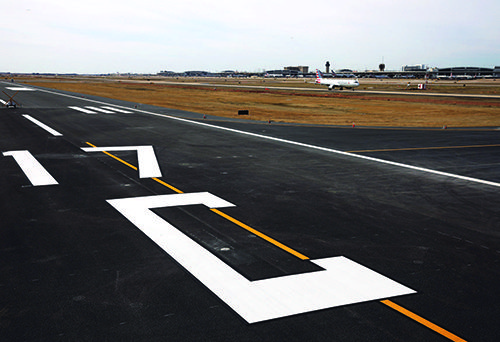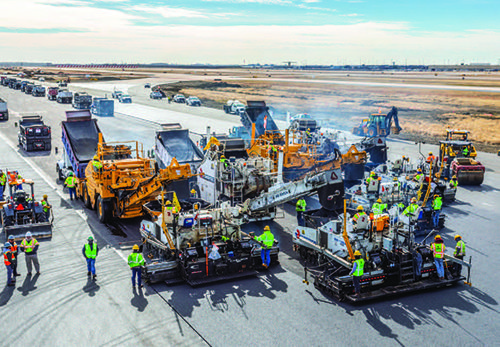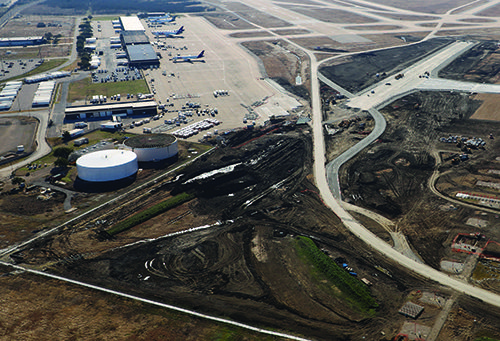After nearly 35 years of service and approximately 650,000 arrivals and departures, the primary arrivals runway at Dallas Fort Worth International Airport (DFW) was due for a significant facelift. The $135 million project that provided it was the first full runway rehabilitation effort since the airport opened in 1974—and its first asphalt overlay.
After nearly 35 years of service and approximately 650,000 arrivals and departures, the primary arrivals runway at Dallas Fort Worth International Airport (DFW) was due for a significant facelift. The $135 million project that provided it was the first full runway rehabilitation effort since the airport opened in 1974—and its first asphalt overlay.
 Prior to the project, the rate of pavement deterioration and the consequent maintenance costs for Runway 17C-35C were increasing drastically, explains DFW Project and Design Management Assistant Vice President Smitha Radhakrishnan. “The runway, which handles up to 400 flights a day and 40% of DFW’s arrivals, had reached the point of diminishing returns on expensive repairs, and a full-scale rehabilitation was the only logical solution to extend the life of this asset,” says Radhakrishnan.
Prior to the project, the rate of pavement deterioration and the consequent maintenance costs for Runway 17C-35C were increasing drastically, explains DFW Project and Design Management Assistant Vice President Smitha Radhakrishnan. “The runway, which handles up to 400 flights a day and 40% of DFW’s arrivals, had reached the point of diminishing returns on expensive repairs, and a full-scale rehabilitation was the only logical solution to extend the life of this asset,” says Radhakrishnan.
DFW tasked Jacobs to design and engineer a solution that would best meet four overarching goals:
- shortest downtime during rehabilitation,
- longest possible pavement life,
- minimal interruptions for scheduled maintenance and
- a cost-effective design and construction method that emphasizes sustainability and helps maintain the airport’s carbon-neutral status.
|
facts&figures Project: Runway Rehabilitation Location: Dallas Fort Worth Int’l Airport Cost: $135 million Funding: Capital funds ($80 million); Airport Improvement Program funds ($55 million) Timeline: May 2018 – March 2019 Project Overview: Rehab of airport’s busiest arrivals runway with high-grade asphalt overlay; new drainage system; all-LED lighting conversion Design & Engineering: Jacobs Program & Project Management: AECOM Prime Contractor: Austin Bridge & Road LP Electrical: EAS Contracting Runway Status Lights Shelter: Chambers Engineering Pavement Markings: Hi-Lite Airfield Services Directional Drilling/Jack & Bore: JMEG Underdrain: Renaissance Contractors Sod: Texas Environmental Management Saw & Seal: Diamond Drilling and Sawing Pavement Grooving: Cardinal Int’l Grooving Materials Trucking: FOS Brokerage Services Materials Testing: Terradyne Engineering Concrete Crushing: TBK Materials Drill & Dowel: MCL Contracting Crack Repair & Sealant: Crafco Mastic One Lighting Fixtures: ADB Airfield Solutions Lighting Base Cans & Extensions: Jaquith Industries Airfield Guidance Signs: Lumicurve Award: Construction Mgt. Assoc. of America, North Texas Chapter: Transportation/Aviation $100+ Million |
Jacobs presented the airport with a lifecycle cost analysis for eight scenarios, ranging from full-depth Portland cement concrete (PCC) to asphalt to combinations of the two. Each scenario considered the initial construction cost, long-term maintenance costs over 30 years and operational impacts resulting from runway closure during initial construction and subsequent maintenance, says Jacobs Senior Civil Airfield Engineer Johnny Jackson.
After extensive consultation and deliberation, airport management chose the rehabilitation option that best balanced initial and long-term costs, and also preserved and protected a majority of the existing pavement system, which was determined to be in good condition.
Construction on the 13,401-foot runway began in May 2018 with a partial closure. The runway was fully shut down in August and reopened on March 10, 2019.
Good News
Evaluation of the runway’s existing subgrade found that the cement-treated base and lime-treated subgrade were still in very good condition, which eliminated the need for complete replacement of the concrete pavement and underlying subgrade layers.
“Since 17C is the most trafficked arrivals runway at DFW, it was expected that after thousands of landings most of the runway would be compromised,” Jackson recalls. “But our analysis showed that the runway’s base and the outer lanes still had a lot of life left, giving us more design alternatives.”
AECOM Associate Vice President Pat McCollom, who oversaw project and construction management, notes that the cement-treated base beneath the concrete pavement measured better than crews could make it today. “It told us, as engineers, that it actually got stronger over time,” he relates.
As a result, the chosen plan called for full 17- to 19-inch PCC replacement of the middle 50-foot-by-6,000-foot keel section, full-depth shoulder reconstruction with lime subgrade and recycled concrete base and a minimum 6-inch asphalt overlay on the entire surface.
Choosing an asphalt overlay instead of a full-depth concrete replacement for the entire runway resulted in less demolition, tighter construction schedule and shorter closure time, explains McCollom. It also cost less—$135 million versus $150 million for full concrete replacement. Moreover, an asphalt surface simplifies runway maintenance throughout its 30-year lifecycle because future repairs can be performed at night and the runway does not have to be shut down for extended periods.
As the nation’s first carbon-neutral airport, DFW emphasized environmental sustainability throughout the recently completed project. Concrete material removed from the keel section was taken to a 72-acre materials management site on airport grounds, where crews crushed and recycled it for use on the runway’s shoulders. “We generated 260,000 tons of recycled concrete base,” reports DFW’s Senior Project Manager Mohammad Rehman.
 By recycling the material and not hauling truckload after truckload offsite, the airport minimized its carbon footprint, diverted materials from landfills and saved money, Radhakrishnan points out.
By recycling the material and not hauling truckload after truckload offsite, the airport minimized its carbon footprint, diverted materials from landfills and saved money, Radhakrishnan points out.
A Stiff Mix
Runway 17C-35C is the first asphalt runway at DFW. Before the project team set that precedent, it investigated many other options. “Even though the concrete surface showed a lot of defects, the structure below the top 1 to 2 inches was very sound,” explains McCollom. “With this discovery, we were determined to come up with a design approach that would incorporate this asset into our paving solution.”
Milling the grooves off the existing concrete pavement removed a lot of the surface defects, he informs. Then, crews filled the concrete joints with Crafco Mastic One crack repair and sealant, which is impregnated with sand. The most deteriorated panels were removed and replaced, leaving the underlying cement-treated base in place.
The asphalt mix followed FAA’s P-401 specifications using the Superpave method, wherein asphalt binders are selected based on the expected pavement temperature extremes of the area. At DFW, withstanding the North Texas summer heat was a primary issue. Consequently, the mix was engineered for high stiffness and rutting resistance to accommodate heavy traffic and high-pressure aircraft tires.
FAA specifications called for PG 76-22 binder, whereby 76 refers to the average seven-day maximum pavement design Celsius temperature and 22 the minimum pavement design temperature. In between those two temperature extremes, the binder is designed to retain its elastic recovery properties. The airport’s design stepped up the binder grade to PG 82-22; so it is designed to maintain elasticity in temperatures up to 190 degrees Fahrenheit.
“Although the mix is stiff and harder to place and finish, it will give us a longer service life,” Rehman explains. “We were fortunate because our prime contractor Austin Bridge and Road had a lot of experience with this mix. They placed the same mix on Austin’s Circuit of the Americas Formula 1 racetrack.”
Throughout the project, an onsite batch plant produced 225,000 tons of asphalt.
Let There Be Light
While 17C’s pavement resurface was the catalyst for the rehab, the airport also saw the project as an opportunity to upgrade its airfield lighting and drainage infrastructure.
“Our runway lighting and electrical system was a major consideration,” reflects Rehman. “In January 2017, during a walk of the runway, workers opened some light fixtures and water was bubbling out. We had collapsed conduit where you couldn’t pull a wire through. It was that bad.”
During the recent project, crews replaced the runway’s entire electrical infrastructure with new conduit, wiring and light fixture cans. Work included:
- 7,300 linear feet of 24-inch to 32-inch jack and bore,
- 30,500 linear feet of directional drilling,
- 167,000 linear feet of duct bank,
- 1,700 in-pavement lights and
- a new runway status light shelter.

Drainage work called for 53,000 linear feet of PVC underdrain.
In addition to being DFW’s first asphalt runway, 17C-35C is its first all-LED runway.
“Pilots have been very complimentary on the quality of the runway’s smooth surface and enhanced visibility,” Rehman reports. “The LED lighting is amazing when compared to the incandescent lighting on our other runways.”
The airport plans to convert its remaining runways to LED lighting, notes Radhakrishnan.
Challenges
The runway was originally slated to open in November 2018, but Mother Nature had other plans. She pelted the region with record rainfalls in September and October—the prime months for laying asphalt. The inclement fall weather pushed work into winter, when temperatures often impede paving operations.
“We had 54 inches of rain in September,” Rehman laments.
“And it’s not just [each] rain day,” Radhakrishnan adds. “It’s waiting the two or three days after for surfaces to dry.”
The original schedule called for crews to pave 24 hours a day in temperatures no lower than 50 to 55 degrees Fahrenheit. “We had to pay close attention to temperature and wind conditions throughout November, December and January,” McCollom recalls. “Our last paving day was at the very end of January. And then we had temperature issues with runway striping as well.”

To push the project forward, up to 300 contractors and subcontractors worked 24/7 when the weather permitted—roughly 595,000 total hours of labor. “Our highest production total was 5,000 plus tons of asphalt in one day in December,” Rehman reports. “Every opportunity we got, we just cranked it out.”
Given the large contingent of workers, the airport instituted a certified movement area escort program that allowed contractor personnel trained in airport operations to guide materials and workers throughout the secure airfield areas.
Clay Stark, senior project manager for Austin Bridge and Road, says the escort program was a big, big help. “We didn’t have to wait for dedicated escorts from airport operations to move us around the airfield, which is a production killer,” explains Stark. “That’s a big deal when working in secure airfield areas.”
On a related note, he also credits airport management for addressing access concerns: “When we had issues with the gate, the airport allowed alternate access so we could get materials in through one gate and personnel in and out through another.”
As with other large airfield projects, communication, flexibility and collaboration were key issues. “We had to learn on the fly along the way,” Radhakrishnan reflects. “We had to be toe-to-toe with operations, the FAA, all our stakeholders—ready to respond to any curveballs thrown our way. With the congestion and materials we needed to get in and out of the airfield on any given day, we learned through trial and error. But it was very encouraging to see how the various departments at the airport geared up and stepped up to achieve the common goal.”
Overall, Rehman gives the DFW runway rehab high marks. “I’ve worked on numerous projects at different airports, and I can truly say this was a well-executed project,” he reflects.

Lessons Learned
A couple months before the17C-35C rehab was finished, airport management interviewed 140 stakeholders and project participants about the project. Input about what did/didn’t work will be applied to DFW’s next big runway project.
Several participants mentioned that providing more than one access point for the jobsite increased productivity. Having the runway designers onsite to help project managers and contractors evaluate problems and resolve issues quickly was also highlighted as a timesaver and valuable benefit. During the planning phases, including an airline representative as an integral member of the team was very helpful with decision-making, adds Radhakrishnan.
In retrospect, the airport learned that the partial closure of Runway 17C from May to August was of limited value. The shortened runway was seldom used because pilots requested alternate runways, explains Radhakrishnan. “For the next runway project, we will do as much prep work at night and outside the safety zone as possible before shutting the runway down,” she says.
Members of the design, construction management and construction team emphasize DFW’s positive role throughout the project. Speaking with extensive experience as an aviation construction project manager, Stark notes that DFW was extremely cooperative during both preconstruction and construction activities. “Here at DFW, management wanted to help us be successful,” he emphasizes. “Partnership with the owner played a critical role in making this project successful.”



